
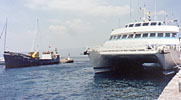
Remember, we were staying at a hotel away from the city centre, near the aiport on the coast south of Pireus, and we had been told that nothing much would be open to do in the city on Orthodox Easter Sunday, so we had booked a three-island cruise.
We were up at 6 for the cruise pickup at 7:15. The breakfast was adequate, but we had become accustomed to much better since we arrived first in Greece. There were red-green and blue hard-boiled eggs in one basket, presumably as an Easter decoration. The people from our hotel were taken to the wharf in a car and two taxis, rather than a bus we expected. The road is all along the shore, and is quite pretty, with a view across the bay to Piraeus and Salamis. As we arrived, we saw a warship in the harbour, which led to the question of why a boat that does cruises is not a cruiser, and a cruiser does not do cruises.
 |
 |
There were several cruise boats at dock, all accepting passenger from many buses. Ours was not a cruiser, but a big catamaran with three passenger decks. We were fairly early, and we were able to choose what seemed like good seats. Eventually there were lots of people, and it turned out that it was much better to wander around than to stay in one place. There was one fairly large group talking a language of a character we didn't know. We called it "Hungarian," but it could as easily have been Turkish, since this year Turkish tourists have been welcomed in Greece.
The catamaran is a fast boat. There were at least three different boats going the same route, which we passed from time to time as if they were standing still. Our first stop was in Epidauros. It turns out that the town is a long way from the big theatre we saw on the first day of our Classical Greece bus tour, so we couldn't walk over to see it again. We had a while to wander around, which we did mainly outside the shopping area, among the family houses. What we saw there, and everywhere we stopped that day, was that just about every family was roasting a whole lamb on a spit. In Idhra, we even saw one apparently single man roasting a small one on his balcony. One wonders how they could eat all that lamb, because they really couldn't invite the neighbours, the neighbours already having their own roasting lamb.
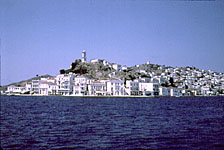 |
| Ihdra from a 35mm slide taken in 1963 |
There were four stops, Epidauros, Hydra (Ihdra), Poros, and Aegina. All the stops allowed a stroll around the port, but no more. In 1963, the stop at Aegina had included a climb up to the Temple of Afaia, but on this trip we stopped at the big port of Aegina, which is on the opposite side of the island. I think also in 1963 the stop was on the other side of Ihdra as well, because the land and port configuration was quite different from my memory (and from a picture I took then). The Ihdra I visited in 1963 had an open wharf with shops alongside, whereas on this trip the harbour was in a bay between steep hills.
We had quite a long time to wander up and down the hills of Hydra, and to sit around enjoying coffee and ice-cream (there was no need for a meal, because a good buffet lunch was served on the boat).
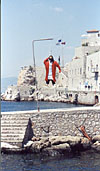 |
 |
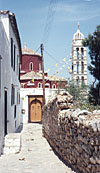 |
We assume that the effigy hanging on the harbour wall represents some particular person in Greek or Ihdra history, but have no idea who it might be. While we were walking around, the air was full of the sounds of explosions echoing off the hillsides, some of them quite deafening. We saw one man and his small son setting off several fire-crackers one after the other in a small street. It seems that the competition is to make both the most and the biggest bangs! |
| Ihdra. (Left) Another hanging effigy, Venetian fortification in background. (Centre) One of the other cruise boats in dock. (Right) a church of an unusual red colour. |
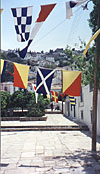 |
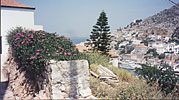 |
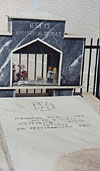 |
| Ihdra. (Left) Flags for Easter. (Above) The harbour. Our Catamaran is visible. (Right) The grave of a priest, with a complete meal set out in the windowed niche. |
| From Ihdra we started back toward Athens. The first stop was Poros, an island separated by a very narrow waterway from the Pelopponese mainland. Again we stopped for a stroll around town, but there was nothing very remarkable about it. A warship was in the port (around the back of the town from what you can see in the picture). | 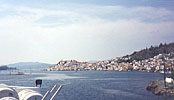 |
| Coming in toward Poros through the narrow channel. |
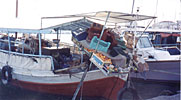 |
The last place we went was Aegina, where pistachios seemed to be a major trading item. It was a bit disappointing that we were at the wrong part of the island to go up to the Temple of Afaia, but I suppose that there were som many more tourists on this big boat, compared to the few that were on the trip I took in 1963 that it might have been impractical to provide mules for everyone. |
| Selling fruit off a boat in Aegina harbour. |
 |
| A panorama of the harbour of Aegina town. The hills in the background are where the Temple of Afaia is. Click on this small version to see a bigger version you can scroll across. |
On the trip as a whole, the islands were pretty, but it was more interesting watching the passengers, especially a bunch of student-aged ones from a variety of countries (US, Canada, Germany, Russia, among others), who got acquainted and then jovially and animatedly drunk together.
When we arrived back at the wharf, most people got on the buses for their different downtown hotels. Seven of us from the Hotel Fenix did not have a bus, and we were repeatedly assured that taxis would come for us. But they didn't, and eventually someone who seemed to be a manager took four of us in his private car. I don't know how the other three got back, but presumably they did.
After looking elsewhere, and finding everywhere closed, we ate a quite nice and not expensive dinner in the hotel.
The next morning we were up at a civilized early hour, and after breakfast we were driven in a hotel shuttle bus to the Air Terminal. Another "interesting" experience with Olympic Airways, who handle the check-in for Turkish Airlines. There were two check-in lines. We got into the one that the TV sign said was for Economy Class. But then they switched, so we moved over to the other line. Soon they switched back again, but we stayed in the line that now said it was Business Class. When we checked in, we found that we had been given business class seats and a pass to the business class lounge. So we took advantage of that and relaxed reading English language papers, and partaking of coffee and cookies until our flight was called.
 |
| Leaving Athens for the second time. Another view of Pireus. |
We didn't know whether Turkey would allow us to bring in alcohol, so we didn't take advantage of the duty free shop. Soon our flight was called, and we boarded the Turkish Airline plane. It was such a contrast to the Olympic Airlines experience. We had big, comfortable seats, and were served champagne and orange juice as soon as we sat down. So much for whether there would be alcohol in the Turkish domain! Since this is the transition from Greece to Turkey, here we move to a new page.